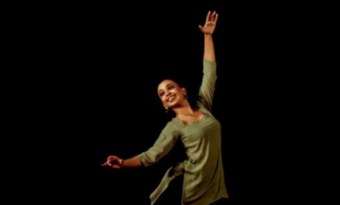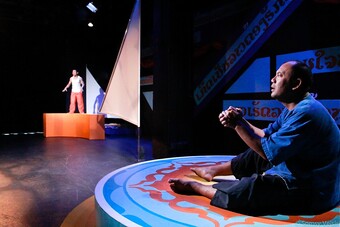Writing the Fight
Part 1 of 2
What Playwrights and Dramaturgs Need to Know About Staging Violence
“Be well versed in the arts of pen and sword.” – Miyamoto Musashi, The Book of Five Rings
These two articles are based on a workshop I’ve taught at venues that include ATHE (Association for Theatre in Higher Education), Region I KC/ACTF (Kennedy Center/American College Theatre Festival) , The Last Frontier Theatre Conference, and other organizations. The idea for it was based both in the experience of fight directing premieres of new plays and from my own experiences in the classroom during my MFA in playwriting.
There are two areas that playwrights and dramaturgs should consider with new plays: dramaturgy (or in these cases, what I’ve come to call fightaturgy), and production concerns.
I’ll begin with fightaturgy. Many of us are familiar with Anton Chekhov’s statement that if a gun is hung on the wall in the first act, it should be used in the third. I would suggest that this statement be reversed. That is to say, for violence to be dramaturgically motivated and add to the structure of the story, it should be set up in other parts of the play than where the actual acts of violence take place.
One scene I have seen played out many times over in various readings of new work is one character confronting another, pulling out a weapon of some kind, and explaining at length, while the weapon is drawn, why they have tracked down their adversary and why they may or may not escalate the violence. In almost every instance, the scene loses all momentum and tension as it has very few places to go.
By way of comparison, I’d like to cite one of the most successful confrontations of this kind. Inigo Montoya’s meeting with the Six-Fingered Man in The Princess Bride (which, as has recently been announced, is being adapted for the stage). Among the most famous lines in the movie is, “Hello. My name is Inigo Montoya. You killed my father. Prepare to die.” The thing about this line in the context of the confrontation is this: it is set up very early in the film. If not for the setup, the line might go something like, “Hello, my name is Inigo Montoya. When I was a small boy, you came to my village and asked my father to forge you a sword. Then…” and so on.
Some plays in which “the gun is hung successfully” that serve as excellent examples of motivated violence include August Wilson’s Ma Rainey’s Black Bottom, in which the groundwork for the fight that ends the play is established by an earlier physical confrontation, wherein both the weapon and the mentality required to use it are established. Another is Burn This, where Burton’s expertise in martial arts is introduced in a comical exchange several scenes before he uses them in a violent confrontation. I would also add Zoo Story, in which the violence that ends the play is crafted into the play long before it actually happens. Another example is Romeo and Juliet in which the culture of dueling permeates the play throughout.
Fightaturgical concerns to keep in mind include: How does violence and/or the threat of violence change or influence character relationships? (This includes those characters not engaged in the acts of violence.) How does violence help or inhibit characters from achieving their wants and objectives? What are the characters’ relationships to violence? Are they from an environment in which it is a normal solution to a problem? Or is violence a line that has never before been crossed? (There is an excellent juxtaposition of these sorts of characters in Mrożek’s Tango.) Remember that a first slap signals a powerful change of relationship (as does a first kiss), and that a fight that does not go as expected changes relationships in ways that will be contrary to the instigating characters’ goals.
Other related subjects involved in fightaturgy include firearms, martial arts, trauma history of characters, whether or not characters are concerned with legal ramifications of their actions (Romeo and Juliet is full of this), and how characters deal with consequences.
If violence is a factor in your play (from a slap to a nuclear war), remember that it is an extreme escalation of conflict in pursuit of an objective, and consider the fightaturgy as you apply it to your story.
Next, concerns of stagecraft and considering the realities of rehearsal and performance.











Comments
The article is just the start of the conversation—we want to know what you think about this subject, too! HowlRound is a space for knowledge-sharing, and we welcome spirited, thoughtful, and on-topic dialogue. Find our full comments policy here